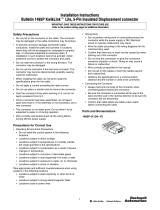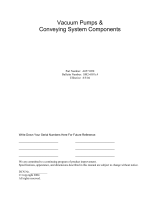
7/50D Plus or 7/50D Controller Chapter 1: Safety 4
CHAPTER 4: OPERATION ........................................................ 54
4-1 Overview ...................................................................................................................54
4-2 Starting and Stopping the System............................................................................. 54
4-3 Basic Tasks ............................................................................................................... 55
Reviewing Station Status ....................................................................................55
Reviewing Pump Status ......................................................................................57
Logging On and Logging Off ...............................................................................59
Enabling and Disabling Stations and Pumps.......................................................60
Reviewing and Adjusting Basic Station Settings .................................................61
4-4 Advanced Tasks........................................................................................................ 64
Reviewing and Resetting a Pump Hour Meter ....................................................65
Transferring Stations to a Standby Pump............................................................66
3-5 Alarms ....................................................................................................................... 69
Reviewing Alarms................................................................................................69
Clearing the Alarm Log........................................................................................70
Silencing Alarms..................................................................................................71
CHAPTER 5: MAINTENANCE .................................................. 72
5-1 Preventative Maintenance......................................................................................... 72
5-2 Corrective Maintenance ............................................................................................ 72
Network Scanner Module Considerations ...........................................................72
CHAPTER 6: CONFIGURABLE SETTINGS............................. 73
6-1 Memory Module Considerations................................................................................73
6-2 Options for Station Setup .......................................................................................... 73
6-3 Options for Pump Setup ............................................................................................ 78
CHAPTER 7: TROUBLESHOOTING ........................................ 80
7-1 General Troubleshooting........................................................................................... 80
7-2 Alarms.......................................................................................................................... 81
Station Alarms .....................................................................................................81
Pump Alarms.......................................................................................................82
System Alarms ....................................................................................................83
CHAPTER 8: APPENDIX .......................................................... 84
8-1 Warranty....................................................................................................................84
Warranty Specifications.........................................Error! Bookmark not defined.
Warranty Restrictions ............................................Error! Bookmark not defined.
Warranty Liabilities ................................................Error! Bookmark not defined.
Customer Responsibilities.....................................Error! Bookmark not defined.
8-2 Optional Components................................................................................................ 84
8-3 Drawings and Diagrams ............................................................................................ 85
8-4 Spare Parts List......................................................................................................... 88
AC Voltage ..........................................................................................................88
DC Voltage ..........................................................................................................88
8-5 Returned Material Policy ...........................................................................................88
Credit Returns .....................................................................................................88
Warranty Returns ................................................................................................89























